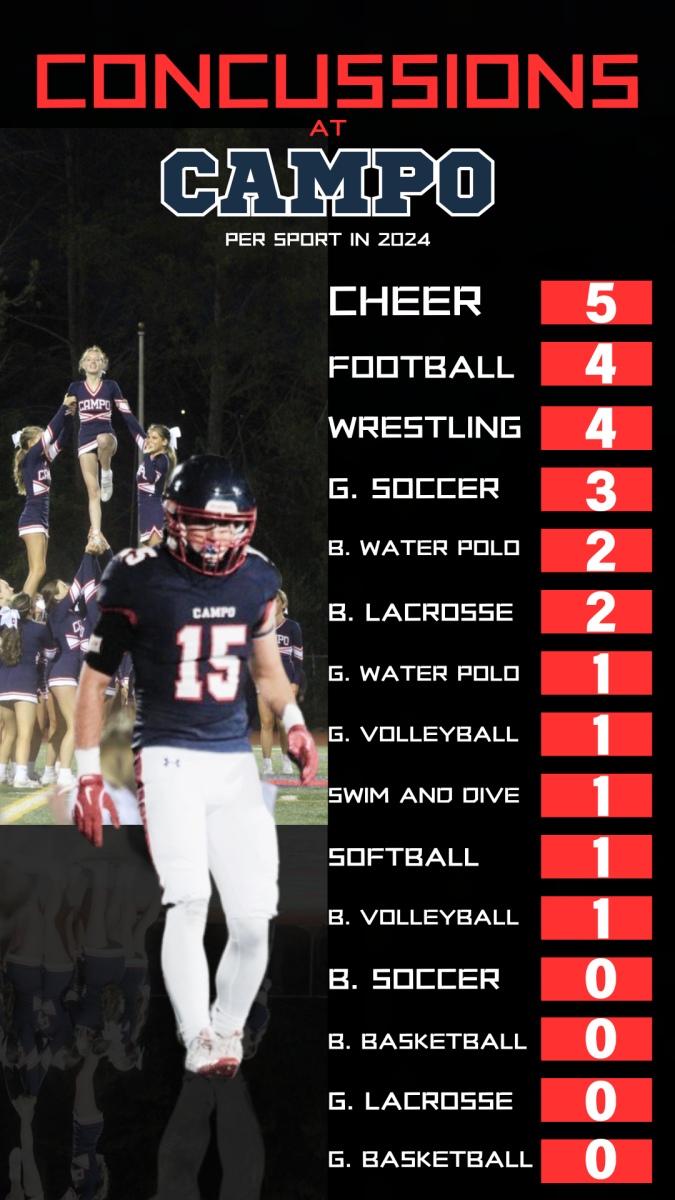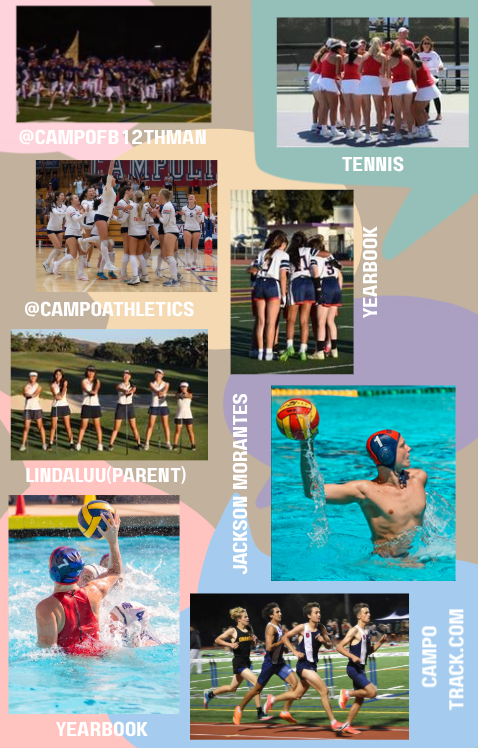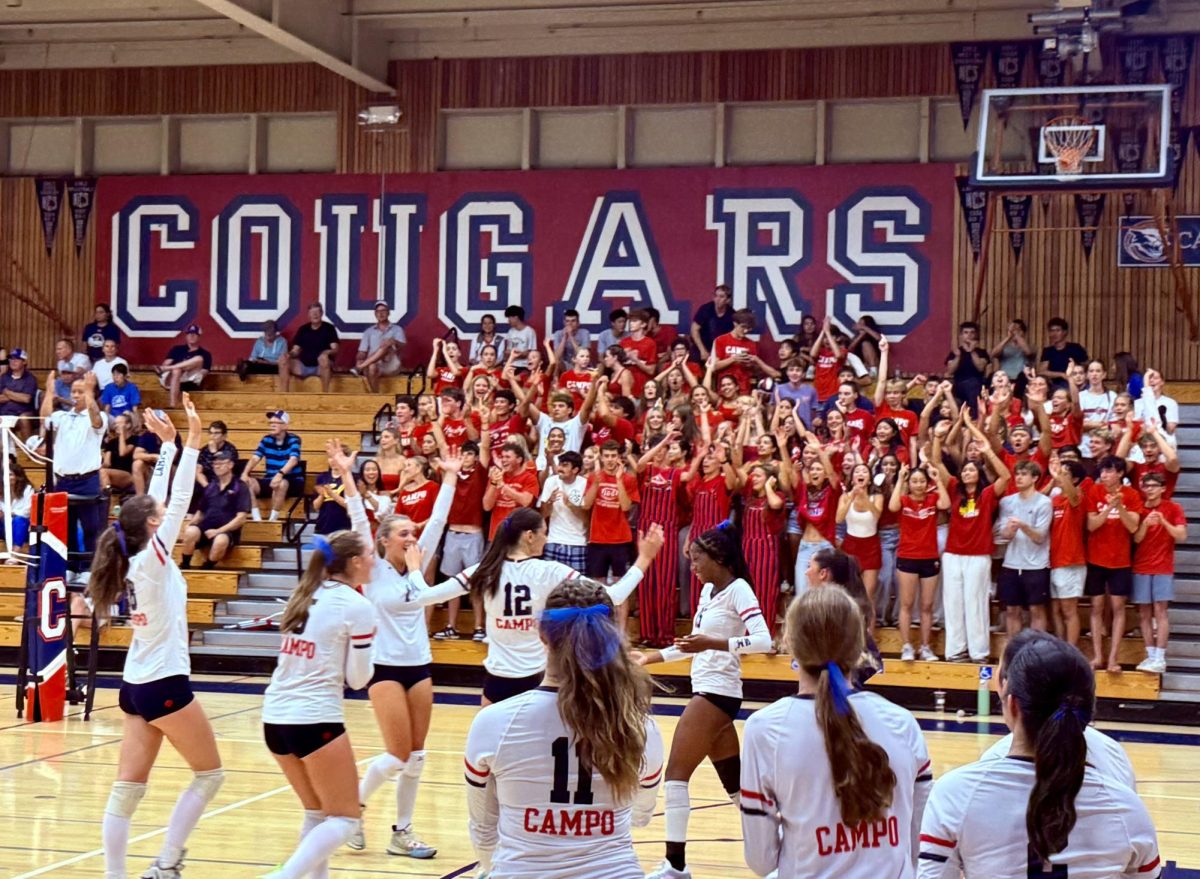For decades, contact sports like football, lacrosse, and soccer have been a focus of concern about concussions. But it turns out it might be just as dangerous to cheer on the sidelines as it is to be playing on the field.
An investigation conducted by The Claw has found that the sport at Campo with the most reported concussions is cheerleading. The survey took data from the 2024 season of 15 varsity sports at Campo.
We looked at data from the fall seasons of football, girls and boys water polo, and girls volleyball; we also looked at the 2024 winter and spring seasons of wrestling, boys and girls soccer, girls and boys basketball, boys and girls lacrosse, boys volleyball, softball, and swim and dive. Since cheerleading is a year-around sport, we used the calendar year of 2024 as their “season,” which may be one reason why cheerleading had higher concussion numbers.
The study found that cheerleading had 5 reported concussions; followed by football with 4; wrestling (4); girl’s soccer (3); boys water polo (2); boys lacrosse (2); girls water polo (1); girls volleyball (1); swim and dive (1); softball (1); boys volleyball (1); boys soccer (0); boys basketball (0); girls lacrosse (0); girls basketball (0).
Yet athletes in several Campo sports say that the official numbers almost certainly undercount concussions since they are not always reported.
Senior cheerleader Charlotte Goodman says some athletes feel there is an incentive not to report a concussion, partly because it means they can’t return to the sport immediately. She said she was surprised that the official number of concussions for her sport was five. “That’s a lot lower than I thought,” she said, estimating that the actual number was double.
According to the California Interscholastic Federation’s (CIF) concussion protocol, an athlete diagnosed with a concussion can only go back to the sport with a doctor’s clearance. The reason for this is because while the brain is healing from a concussion, it is more vulnerable to being injured again. If you sustain a second injury, it could result in severe damage to the brain.
Goodman says injuries in cheer typically occur more in practice than competition, often because flyers fall and hit their head or because bases and backspots (who catch the flyers) get hit by falling flyers. There’s a lot of “elbows, knees and heads colliding,” said Goodman.
Another cheerleader, who spoke on condition of anonymity, shared that she experienced a blow to the head in practice and suspected she might have had a concussion but chose not to go to the doctor because she didn’t want her absence to affect her entire stunt group.
“If you get taken out, then you can’t stunt and your whole stunt group is messed up,” she said.
That mentality is common across sports.
Junior water polo player Jasper Brock-Utne says he has had seven concussions, one of which he did not report, since he started playing water polo at age eight. Two of his concussions were on the Campo team, and he reported both. He says the main causes of concussions in the water are by “elbows, sometimes knees, or just ball to head.”
Goalies in water polo have started to wear padded swim caps in practice in an effort to cut down the risk of head injuries. Despite this, a study by the National Institute of Health on the headgear found that the helmets lack “features that aim to attenuate head kinematics” – in other words, the helmets were deemed not fully effective in preventing concussions. Brock-Utne says “the caps aren’t going to stop an elbow or a knee, they’re just going to stop a ball.”
Senior football player Elliot Frick, who played on the offensive line, said he could “almost guarantee” he had a concussion this past season and never reported it so he wouldn’t “mess up the flow of the team.” One concussion could “mess everything up” for the team, Frick said.
Football coach Kevin Macy says that over the years the sport has been making strides towards becoming safer, despite continued risks and other injuries that occur like broken bones and sprains. Helmet technology has been a game changer for football safety, along with the elimination of several dangerous practice drills. This includes the “Oklahoma drill,” where two players charge at each other in a confined space to test their blocking and tackling skills, hitting one another as hard as they can.
A recent study by the National High School Sports-Related Injury Surveillance found that female athletes have higher rates of concussion than their male counterparts. While the exact reasons are unknown, one theory is that girls have less developed neck muscles than boys- a weaker neck means the head moves more if it sustains a blow to the head.
Competitive cheer head coach Selin Wold believes that her team is taking the necessary strides towards making cheerleading safer. “Safety is our number one concern, and throughout the year, we emphasized to the cheerleaders that they must inform the coaches of any type of injuries they have,” she said. The team recently made the move down from the “Intermediate” difficulty level to the “Novice” level, which several cheerleaders said they hoped could reduce the number of injuries because of less technical stunts. Wold says that the team chose to move down to “Novice” because it was “a more appropriate division for our team.” So far, the team has found success at the level, placing 3rd in their division at the USA Nationals in February.
_ _
Concussions can be caused by impact to the head or body and can be caused by a direct hit or simply from falling. Some of the symptoms, which can come up to two days after impact, could include confusion, dizziness, or (”seeing stars”), headache, nausea, vomiting, fatigue, or sensitivity to light. If you think you might have a concussion, tell your coach or consult an athletic trainer or doctor.




